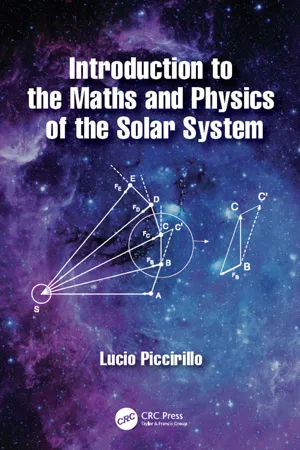
This is a test
- 225 pages
- English
- ePUB (mobile friendly)
- Available on iOS & Android
eBook - ePub
Introduction to the Maths and Physics of the Solar System
Book details
Book preview
Table of contents
Citations
About This Book
This book provides readers with an understanding of the basic physics and mathematics that governs our solar system. It explores the mechanics of our Sun and planets; their orbits, tides, eclipses and many other fascinating phenomena. This book is a valuable resource for undergraduate students studying astronomy and should be used in conjunction with other introductory astronomy textbooks in the field to provide additional learning opportunities.
Features:
-
- Written in an engaging and approachable manner, with fully explained mathematics and physics concepts
-
- Suitable as a companion to all introductory astronomy textbooks
- Accessible to a general audience
Frequently asked questions
At the moment all of our mobile-responsive ePub books are available to download via the app. Most of our PDFs are also available to download and we're working on making the final remaining ones downloadable now. Learn more here.
Both plans give you full access to the library and all of Perlego’s features. The only differences are the price and subscription period: With the annual plan you’ll save around 30% compared to 12 months on the monthly plan.
We are an online textbook subscription service, where you can get access to an entire online library for less than the price of a single book per month. With over 1 million books across 1000+ topics, we’ve got you covered! Learn more here.
Look out for the read-aloud symbol on your next book to see if you can listen to it. The read-aloud tool reads text aloud for you, highlighting the text as it is being read. You can pause it, speed it up and slow it down. Learn more here.
Yes, you can access Introduction to the Maths and Physics of the Solar System by Lucio Piccirillo in PDF and/or ePUB format, as well as other popular books in Physical Sciences & Astronomy & Astrophysics. We have over one million books available in our catalogue for you to explore.
Information
CHAPTER 1
Basic Concepts
CONTENTS
1.1 Geometry
1.2 Trigonometry
1.3 Calculus
1.3.1 Functions
1.3.2 Infinity in Maths
1.3.3 Derivatives, Integrals and the Fundamental Theorem of Calculus
1.3.4 Inverse Trigonometric Functions
1.4 Eratosthenes’s final calculation
1.5 Aristarchus’s calculations
THERE are several elementary concepts that need to be properly reviewed in order to fully understand the phenomena happening in our solar system. Obviously, we do not have here the space or the time to review the entirety of geometry, trigonometry, calculus, etc. However, especially for those readers that need to refresh concepts that haven’t been used in some time, we treat in some detail most of the useful mathematical concepts that will be used in later chapters, especially the chapter on celestial mechanics. Our treatment is by no means rigorous and is mostly used to prove statements about our world and, more specifically, our solar system. We will see in the next few sections how the knowledge of very simple geometry has allowed ancient Greek philosophers to state that not only the Earth is spherical, but also estimate the distance from the Earth to the Moon and the Earth to the Sun.
We will use the Greek philosophers’ amazing achievements as an excuse to introduce some of the concepts that are needed in the rest of the book putting considerable attention to show how maths is deeply used – we would say embedded – in the physical world. We will also often digress to show how systems and concepts apparently disconnected from the study of the solar system are actually used, sometimes so automatically that we forget how important they are. An example is the case of digital electronics and logic circuits inside computers.
1.1 GEOMETRY
Now imagine you are a Greek philosopher, named Eratosthenes (see fig. 1.1), residing in a beautiful city in Egypt (Alexandria). You are taking care of one of the most complete and important libraries in existence and you have time to read, study and think. Somebody has just told you that during one of his trips to Syene (today’s Aswan) in the south of Egypt, he has noticed something weird: at midday of the special day of summer solstice, i.e. the longest day and shortest night of the year, the Sun shone directly down a deep vertical well. In other words, looking directly down the well, your head blocks exactly the reflection of the Sun by the water at the bottom of the well. The majority of people when confronted with the news would simply think “that’s strange” and then go back to their lives. But you have time to think … and you run outside at midday of the summer solstice in your city of Alexandria and plant a vertical stick in the ground to check if the Sun is overhead in Alexandria as well. It is not! You have time to think … and all of a sudden you know what all means: the Earth is not flat, it is a sphere! Not only that, but you are capable...
Table of contents
- Cover
- Half Title
- Title Page
- Copyright Page
- Dedication
- Table of Contents
- Foreword
- Preface
- Chapter 1 ■ Basic Concepts
- Chapter 2 ■ Math and Physics Toolkit
- Chapter 3 ■ Celestial Mechanics
- Chapter 4 ■ A Few Facts about the Solar System
- Bibliography
- Index